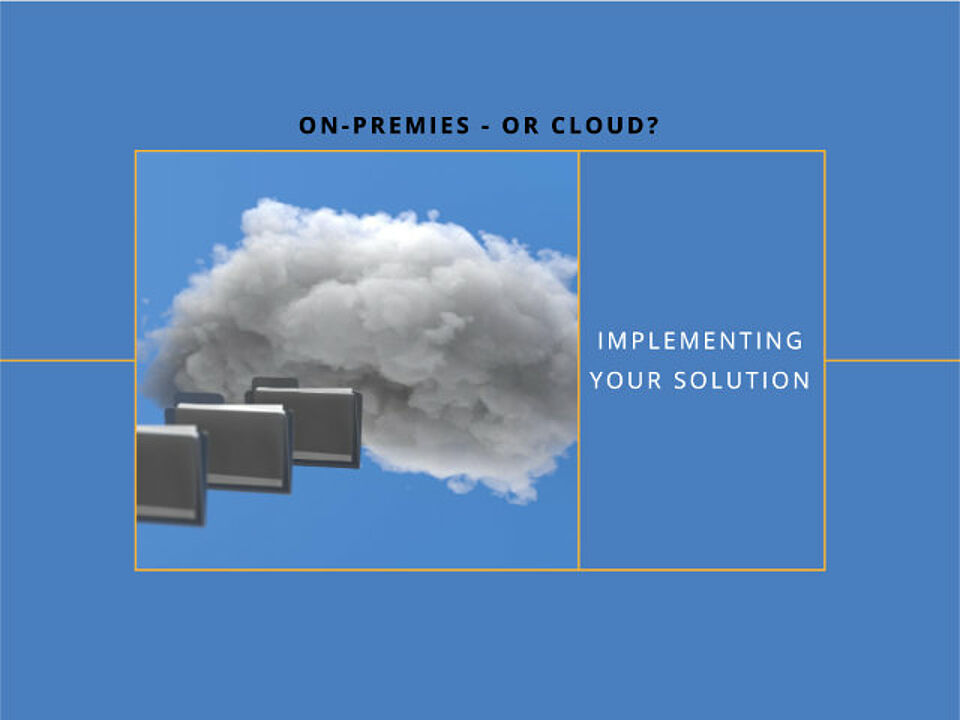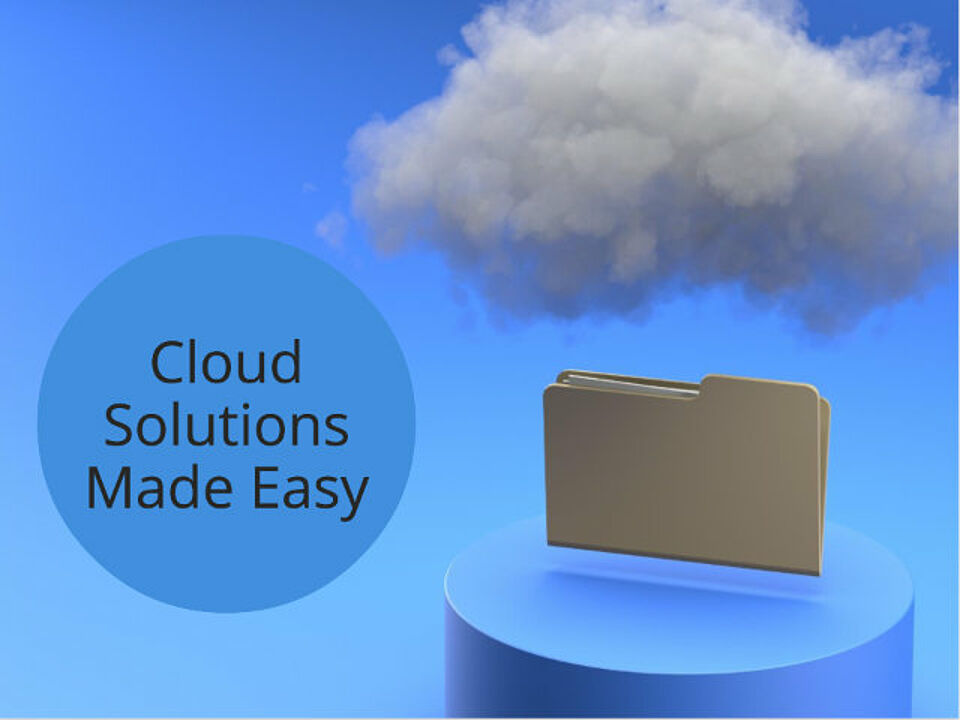
Author: Jochen Möller (Geschäftsführer and CoFounder of EcholoN)
Created on: 14.04.2018, last change: 21.03.2025
Table of content
Advantages of on-premises software
Advantages of the cloud solution
Cloud or on-premise solution - which investment is worthwhile in the long term?
EcholoN with a hybrid model for on-premises, cloud solution for purchase or rental - utilisation
When it comes to purchasing new software, there are many decisions to be made: What can the software do? How much does it cost? Is it easy to use? But one of the key considerations is the type of installation of the software: should it be operated directly on site (on-premise) or in the cloud? The answer to this depends heavily on the philosophy of your company and your existing IT infrastructure. Both options have their own advantages and challenges, which we would like to look at in more detail here.
Definition: On-premise - everything in your own hands
With the on-premise solution, the software is installed directly on the company's own servers. The required infrastructure with hardware - whether servers or other components - is provided either by the in-house IT department or an external service provider. It is important that these systems fulfil the specific requirements of the software, particularly in terms of performance and efficiency. The systems must be specifically customised to the software and set up on the appropriate platform as required. Who carries out the installation - the internal IT department or the software provider directly - depends on the individual agreements. As the customer, you bear full responsibility for the maintenance of these systems. This includes carrying out regular data backups, whether manual or automated, and installing security updates.

Advantages of on-premises software
- All data is under our own control and infrastructure - Data security
- Updates and version updates independent of the software provider
- The only solution for high security and data protection requirements
- Unrestricted access to the application without an internet connection
Disadvantages of on-premises software
- Costs for infrastructure if it is outdated or not yet available
- Build up own know-how for the software / coordination with software provider
- Operation with maintenance and servicing by own staff
- Responsibility for the infrastructure with security updates
Definition: Cloud solution - data is stored with the service provider
In a cloud solution, the software is provided in the infrastructure of the software provider. These systems are not usually owned by the provider, but are hosted in a data centre of a data centre service provider
The software provider handles the setup and configuration, known as onboarding. This also includes regular maintenance of the server systems, including the installation of security updates. The same applies to data backup with the corresponding backup scenario (regular backups, transfer to different backup targets, etc.). The software provider is responsible in the event of malfunctions or failures. Absolute availability and response times are usually agreed.

Advantages of the cloud solution
- No acquisition costs for infrastructure and systems
- Operation with maintenance and servicing by the software provider
- Security and redundancy, e.g. for the power supply, are the responsibility of the provider
- Rapid availability, scalability and high flexibility of the software solution
Disadvantages of a cloud solution
- Stable and fast internet connection with corresponding bandwidth
- High dependency on the software provider for operation and security (current patches, rectification of security gaps)
- Data storage is not in your own hands
- Reliance on data protection: coordination of own data protection guidelines with those of the provider
- Dependence on price adjustments and ongoing costs, storage space
- No simple switch from cloud to on-premise or cloud to new cloud provider
Cloud or on-premise solution - which investment is worthwhile in the long term?
One-off costs vs. ongoing costs - which model is more economical?
For long-term investments, you should carefully weigh up the one-off costs of an on-premise solution against the ongoing costs of a cloud solution
The decision between the two options can have a significant impact on the profitability of your company. The choice depends on your company's specific requirements, objectives and resources.
One-off costs (on-premise)
Advantages:
- Control and security: The company has full control over its infrastructure and data. This is especially true for industries with very strict data protection requirements.
- One-off investment: After the initial investment, there are lower ongoing costs as the infrastructure can be used for a longer period and for additional services.
- Industries with high profit margins: Here, a high investment in new licence and hardware technologies can lead to a worthwhile amortisation.
Disadvantages:
- High initial investment: The initial investment for the infrastructure with hardware and software can be considerable.
- Outdated technology: The need to invest in new hardware or upgrade existing hardware can result in unplanned investments.
- Maintenance and operations: Companies are responsible for IT operations with maintenance, updates and resolving IT incidents, which requires additional costs and resources.
Ongoing costs (cloud)
Advantages:
- Scalability: the cloud offers flexibility to quickly ramp up or ramp down resources as needed. This is particularly advantageous for growing companies or companies with fluctuating requirements.
- Maintenance-free: The cloud provider takes care of IT operations with maintenance, updates and security, which frees up IT resources in the company.
- Cost efficiency with lower requirements: For smaller companies or start-ups that do not have the funds for a large upfront investment, a model with ongoing costs can be effective.
Disadvantages:
- Higher costs in the long term: over time, ongoing costs can exceed the one-off investment costs. This happens especially if the service is used extensively and many surcharge items are incurred.
- Dependence on the provider: The company is dependent on the cloud provider. This harbours risks in the event of outages, data sovereignty or price increases.
Final conclusion
As mentioned in the introduction, there is no one-size-fits-all answer to the question of whether you should opt for the on-premise or cloud option. Depending on the size of your company, your corporate culture and any existing legal or company regulations, it may be that it has already been determined in advance that software must always be installed on site.
However, for smaller companies without an extensive IT department, it often makes more sense to opt for a cloud solution in order to save both financial investment and time for IT operations with installation and maintenance. If the software provider guarantees that it will respond quickly in the event of problems and can prove that it works with certified data centres in Germany or the EU, then the advantages outweigh the disadvantages in such cases.
EcholoN with a hybrid model for on-premises, cloud solution for purchase or rental use
EcholoN has a hybrid operating model and you can decide according to your needs and requirements whether you want to buy EcholoN or just use it. This can be in the EcholoN cloud or in your infrastructure.
- On-premise: You have full control over your system and operate your EcholoN service management solution completely in-house
- Cloud-based / SaaS: You favour a cloud solution without burdening your infrastructure and operate your service management software in the EcholoN cloud
- EcholoN Managed Service: You prefer an all-round carefree package and want to concentrate fully on your use cases and processes.
- Hybrid operating model: You can buy/rent EcholoN and host parts in the EcholoN.Cloud and also operate on-premise. For example, if you don't have a DMZ, you can operate the SelfService Portal in our cloud. The same applies to services such as bot and AI support, which you can obtain directly from the EcholoN.Cloud.
